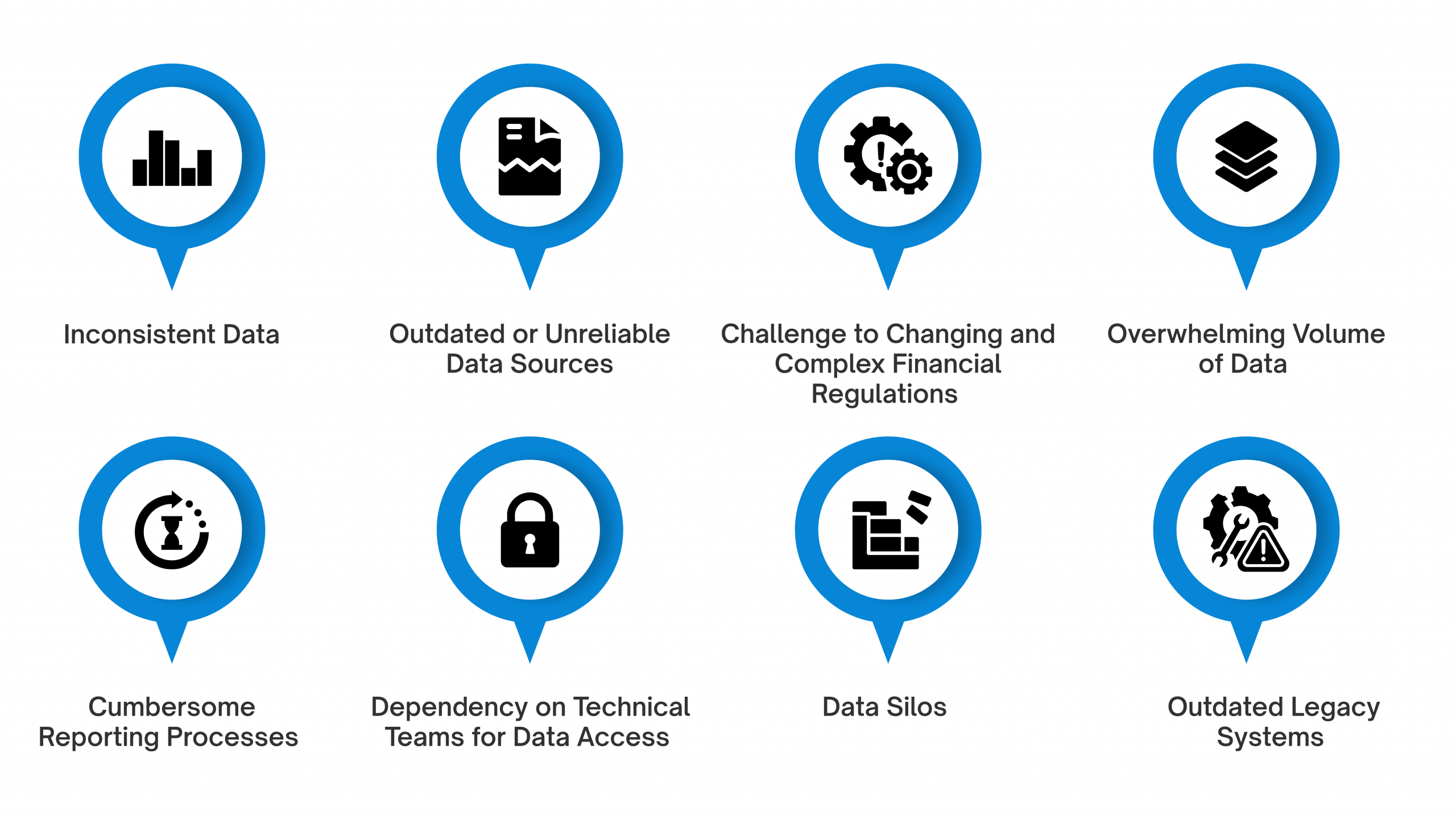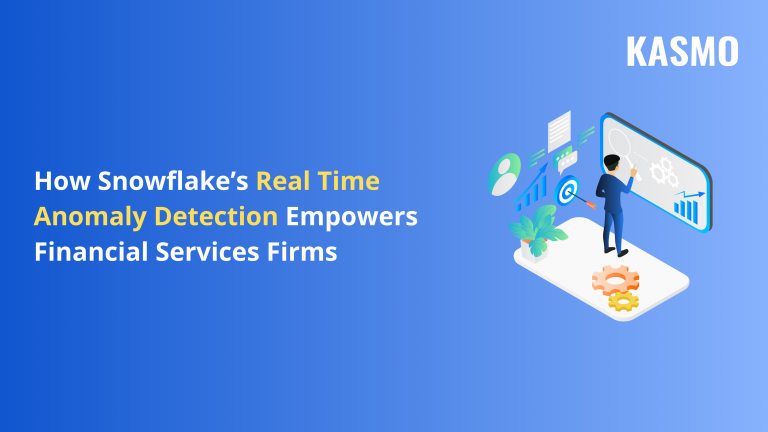What are the Data Challenges Faced by Financial Services?
To make data-driven decisions, financial leaders need better insights and real time anomaly detection. However, due to fragmented and siloed data, financial leaders need a solution that will help them overcome these challenges and harness the full potential of their data.

Inconsistent Data
One of the most pressing issues is data inconsistency. Gaps arise from inconsistent data entry, lack of standardized formats, or using outdated systems. When teams input data manually, they are trapped in silos, critical financial information may go undocumented, leading to inaccurate reports and dashboards.
Outdated or Unreliable Data Sources
Even when data is available, it may not be reliable. Legacy systems, manual processes, and irregular update cycles can result in discrepancies. Financial data trapped in lengthy spreadsheets or scattered across disconnected platforms often lacks consistency, making detecting anomalies in financial data a significant challenge for banks and financial services.
Challenge to Changing and Complex Financial Regulations
Financial institutions must keep pace with complex financial regulations and compliance standards. Inaccurate or fragmented data complicates reporting and increases the chances of financial services falling into penalties. Especially, now, when customers are very cautious and careful about how they share data with banks and other financial institutions, leaders need to create strategies and harness tools that will help them secure customer data as well as adhere to compliance standards.
Overwhelming Volume of Data
Financial services generate data from numerous sources, like transactional systems, social media platforms, payment channels, and more. This increasing volume of structured and unstructured data is difficult to manage without scalable solutions, making real-time anomaly detection for financial services difficult.
Cumbersome Reporting Processes
Financial teams often struggle with delays in preparing reports due to fragmented data sources and lack of automation. Pulling and formatting data manually consumes time and introduces the risk of error, leading to reporting inefficiencies that impact banks and other financial services firms.
Dependency on Technical Teams for Data Access
When your teams are not equipped with self-service analytics tools, finance professionals need to depend on IT teams to access data. This slows down financial analysis and reporting, limiting real-time decision-making capabilities of financial leaders.
Data Silos
In many financial firms, data remains trapped in silos. These silos prevent financial leaders from getting a unified view of their operations, hindering collaboration, and making it difficult to identify anomalies across the organization.
Outdated Legacy Systems
Startups and mid-sized financial institutions often begin with legacy systems to store, access, and analyze their data. However, as their business scales, these legacy systems become insufficient to handle the growing volume of data. Without cloud platforms like Snowflake in place, achieving automated anomaly detection and advanced reporting at scale becomes difficult for financial services.
How Real Time Anomaly Detection Help Financial Services?
With data streaming from various sources like payment systems, credit card companies, and customer engagement platforms, financial institutions must be equipped to detect anomalies in near real time. Waiting hours, or even minutes, to detect anomalies in financial firms can result in significant financial loss (in the event of any fraudulent activity) or operational inefficiencies. That’s why it is crucial that financial services firms need to conduct real time anomaly detection.
Acting on Anomalies Instantly
From payment fraud to irregular trading activities, financial firms can monitor huge volumes of financial data and identify anomalies within seconds. Real time anomaly detection allows organizations to flag suspicious transactions or unusual user behavior as it happens. For instance, a credit card company can immediately reject a fraudulent transaction before it is processed, safeguarding both the customer and the firm.
Enabling High-Speed Monitoring
One of the biggest advantages of automated anomaly detection is – it empowers financial leaders with the ability to scale growing data volumes. Financial data pipelines are massive and continuous, requiring systems that can process anomalies in data without compromising performance. With robust infrastructure, financial services can detect anomalies across millions of transactions or market movements in real time, without delays or manual intervention.
Predicting Issues Before They Escalate
Beyond flagging issues, with anomaly detection, financial services firms can also forecast potential disruptions. By analyzing customer behavioral patterns, these systems provide early warnings for fraud, credit risk, or operational inefficiencies. This encourages leaders to be more insightful while financial planning and allows them to intervene proactively, before any significant loss.
Unlocking Actionable Financial Insights
Real time anomaly detection not only helps financial firms secure their systems but also enables better financial insights by showing hidden patterns. Whether it’s understanding spending surges, investment anomalies, or shifts in customer transactions, automated anomaly detection systems empower institutions to make smarter, faster decisions.
Why Choose Snowflake’s Anomaly Detection
For financial institutions aiming to stay ahead of risk, fraud, and market volatility, Snowflake’s Anomaly Detection offers a powerful, real-time solution. Designed to surface unusual behaviors and outliers across massive financial datasets, it empowers organizations to proactively act on threats and insights as they emerge.
Real-Time Monitoring and Automation
By leveraging Snowflake, financial leaders can perform automated anomaly detection at a scale. Snowflake scans data streams continuously eliminating the need for manual intervention. This immediate detection is critical for flagging anomalies in data, such as suspicious transactions or unexpected market behaviors, before they escalate into larger financial issues.
Built on Machine Learning for Precision
Snowflake uses advanced machine learning algorithms trained in historical financial data along with incremental data to help financial organizations refine their accuracy and reduce significant financial losses. With automated anomaly detection in real time now possible, your teams can now stay alert only to truly abnormal activities, saving time, boosting productivity, and enabling more insightful financial planning.
Seamless Scalability
With Snowflake’s powerful cloud-native infrastructure, financial services firms can analyze vast datasets across business units without slowing performance. Snowflake AI Data Cloud handles everything within a unified, secure environment, removing the need for external data movement and reducing exposure risks.
Use Case: Enhancing Anti-Money Laundering (AML)
Financial institutions are under constant scrutiny to meet compliance standards and protect their firms against fraudulent activities. Snowflake’s Anomaly Detection provides a crucial layer of defense in the fight against money laundering.
- Suspicious Transaction Detection: Snowflake automatically flags anomalies such as frequent fund transfers, fraudulent activity, or transactions that deviate from normal customer behavior. These insights enable timely investigations and intervention.
- Adhere to Compliance Standards: Snowflake’s adaptive ML algorithms prevent financial services firms from straying away from compliance standards, allowing teams to focus on imminent threats.
- Audit-Ready Reporting: Every anomaly identified is logged and traceable, streamlining documentation and ensuring that regulatory requirements are met with precision.
Use Case: Monitoring Market Data Integrity
Real-time access to accurate market data is essential for making data-driven financial decisions. Anomalies in price movements, trading volumes, or data inconsistencies can have a significant impact on financial services firms. Snowflake helps firms detect and respond to such anomalies immediately.
- Spotting Irregular Trends: Unusual spikes in price or volume can be early indicators of fraudulent activities. Snowflake AI Data Cloud helps financial teams monitor these in real time, improving responsiveness and risk management.
- Safeguarding Algorithmic Trading: Trading algorithms rely on clean data. By flagging discrepancies or data whose integrity is compromised, Snowflake ensures these systems function smoothly, helping institutions avoid any major financial loss.
- Improving Risk Management: Identifying market anomalies before they create a dramatic effect across portfolios helps risk managers rethink their financial strategies swiftly, safeguarding capital and ensuring their operation is not compromised.
Conclusion
Traditional methods of financial analysis and reporting are no longer sufficient to handle the scale, speed, and volume of financial data. With Snowflake’s real time anomaly detection, financial services institutions can not only prevent fraud and mitigate compliance risks but also unlock deeper financial insights that drive insightful financial planning and smarter decision-making. Snowflake’s Anomaly Detection empowers teams with scalable, machine learning capabilities that make real-time monitoring seamless and secure. Financial organizations that embrace automated anomaly detection are able to gain faster insights, enhance operational efficiency, and prevent their firms from incurring any major financial loss.







